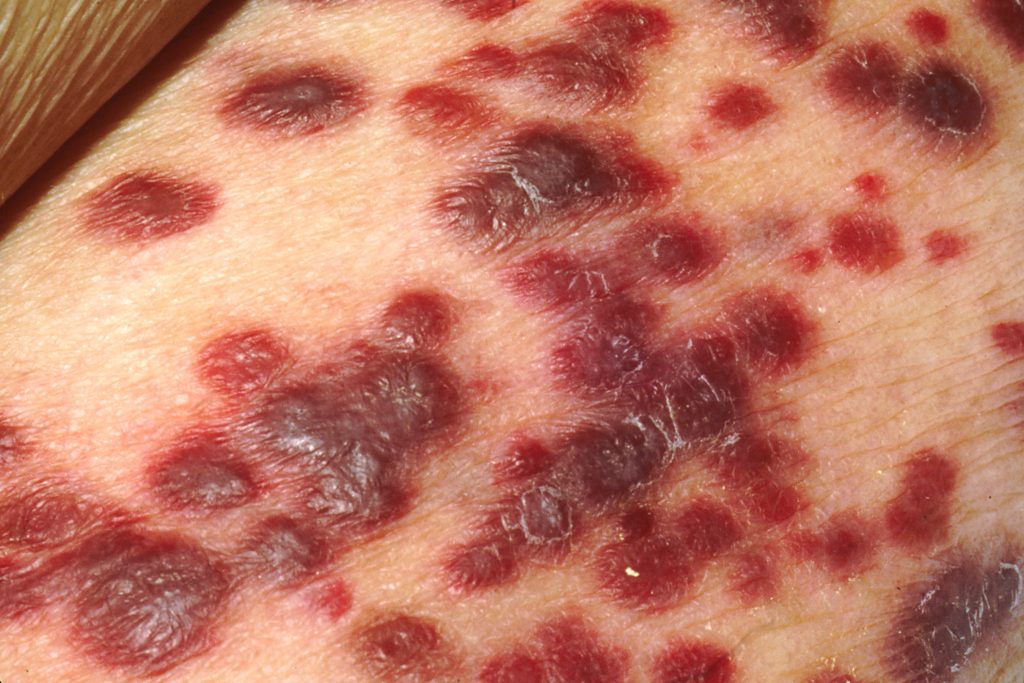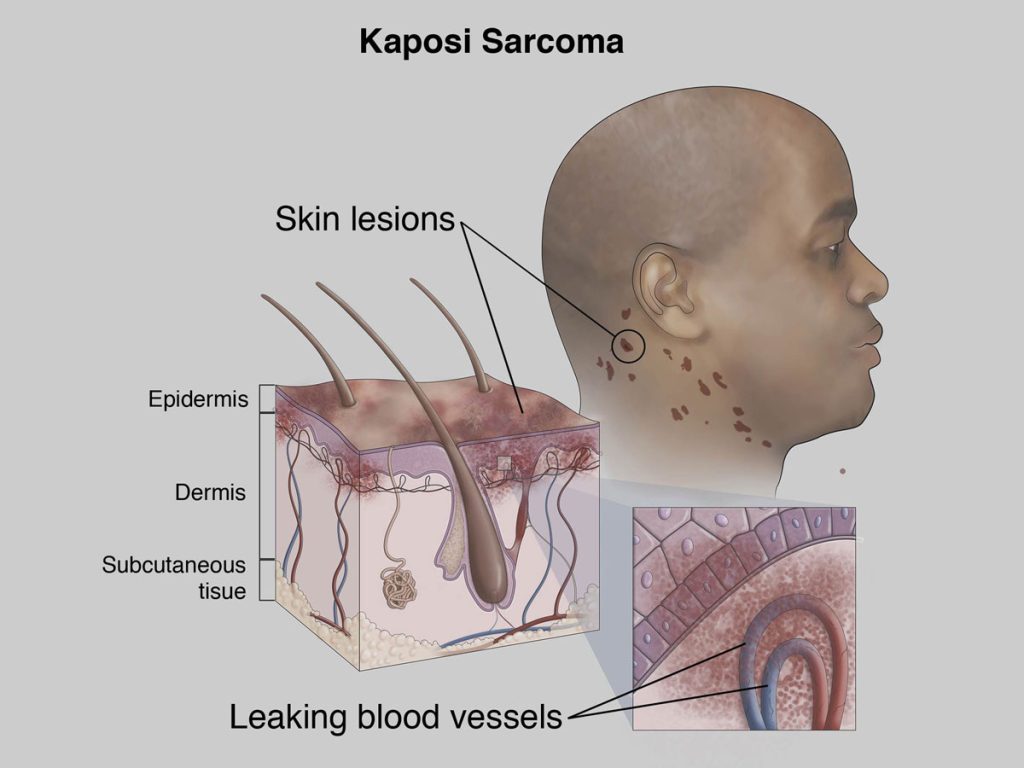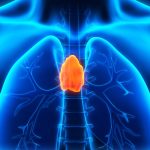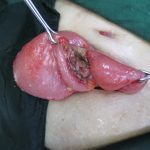
Kaposi’s sarcoma (KS) is a rare type of soft tissue sarcoma. A soft tissue sarcoma is a type of cancer.
What is Kaposi’s sarcoma?
Kaposi’s sarcoma (KS) develops from cells called endothelial cells, which line the blood and lymph vessels. It is most commonly found on the skin, but it can also affect the inside of the body, such as the lymph nodes, lungs, bowel, liver and spleen. KS growths are also called lesions or tumours.
KS develops in a different way from other types of cancer. Most cancers begin in one place in the body and may then spread to other parts of the body (metastasise). KS can start in several areas of the body at the same time.
Causes of Kaposi’s sarcoma
A main cause of KS is a virus called the human herpesvirus 8 (HHV8), also known as Kaposi’s sarcoma associated herpesvirus (KSHV). The virus infects the cells and it is thought that this causes them to become cancerous.
HHV8 is mostly a sexually transmitted virus and is a common infection. It can also pass in blood between drug users who share needles.
Not everyone infected with HHV8 gets KS. It is thought that there are other factors involved. Scientists agree that having a weakened immune system or certain types of infection along with HHV8, also play a part in a person developing KS.

Signs and symptoms of Kaposi’s sarcoma
The signs and symptoms are different, depending on whether you have external KS on the skin or KS inside the body. Lesions on the skin are more common than internal lesions inside the body.
Kaposi’s sarcoma of the skin
Lesions on the skin usually start out very small and flat. They do not cause any pain or itching and seem harmless. They look like a bruise but do not lose their colour when pressed, as a bruise does.
As they grow, they might start to stick up above the surrounding skin and grow into each other. The lesions might be in different colours such as brown, blue, red or deep purple.
Occasionally, the lesions form lumps (nodules) that can become ulcerated and that can bleed. The lumps are associated with painful swelling (oedema).
KS in the skin might grow very slowly and show no changes for a few months. But some grow more quickly, with new areas appearing weekly.
Internal Kaposi’s sarcoma
Internal KS lesions can grow in the lymph nodes and body organs, such as the lungs, liver, spleen and digestive system. The symptoms you have depend on which organs are affected.
The most common type of KS is related to AIDS. In AIDS related KS, it is common for disease to be in the lymph nodes. KS cells can block the flow of lymph (tissue fluid) through the lymphatic system. This build up of fluid can cause swelling in the arms or legs. This is called lymphoedema.
Lymphoedema can be very painful and uncomfortable. Unfortunately, there is no cure for this condition. But treatment can help to control and relieve it. The earlier this is picked up and treated, the easier it is to control. It is important to let your doctor know if you have any swelling that you think might be lymphoedema.

Types of Kaposi’s sarcoma
There are four types of Kaposi’s sarcoma:
- classic KS
- endemic or African KS
- transplant related KS
- AIDS related KS
Classic KS
This type of KS is very rare and is only found on the skin, mainly on the lower legs and feet. It is most common in older men of Mediterranean or Central and Eastern European origin. It can be a slow growing cancer and does not usually cause any problems apart from the appearance of the lesions.
You might not need treatment until the KS lesions are large and in very visible areas of the body.
Endemic or African KS
This type of KS is found in parts of Africa where HHV8 infection is common. It is faster growing than classic KS.
It affects both adults and children.
Transplant related KS
This type of KS is very rare and is most common in people with lowered immunity. This includes people who have had a stem cell or organ transplant. These people need to take drugs to stop their bodies from rejecting the new organ or stem cells. These drugs suppress the immune system. They are called immunosuppressive drugs or immunosuppressants.
AIDS related KS
KS is the most common type of tumour in people infected with HIV. It tends to grow faster than the other types. People with AIDS have a weakened immune system. This increases the risk of developing KS.
Tests
Kaposi’s sarcoma (KS) is usually diagnosed with a biopsy. This means that you have a tissue sample (biopsy) taken. A specialist doctor (pathologist) then looks at the cells under a microscope.
The way you have the biopsy depends on where in your body the lesion is.
Skin lesions
You usually have a biopsy with a local anaesthetic if the lesion is on the skin. A local anaesthetic numbs the area.
Lesions in the lung
You might have a bronchoscopy to collect a biopsy from a lung lesion.
Lesions in the digestive system
You might have an endoscopy or colonoscopy to biopsy lesions in the digestive system.
Other tests might include:
- a blood test
- an MRI scan
- a CT scan
- a PET scan
- a test to check for blood in the stool

Treatment for Kaposi’s sarcoma
Your treatment depends on:
- the type of KS
- the size and location of the lesions
- how severe it is
- your general health
Treatment options for all types of KS might include one or more of the following, depending on whether the lesions are localised or widespread:
- freezing the area with liquid nitrogen (cryotherapy)
- laser treatment
- removing the lesions with a small operation
- radiotherapy to the lesions
- creams applied to the lesions (topical therapy)
- chemotherapy into your bloodstream
- an immunotherapy called interferon alfa
Additional treatments for transplant related KS include:
- stopping an immunosuppressant drug or changing the dose
- an immunosuppressant drug called sirolimus that prevents rejection of a kidney after a kidney transplant
An additional treatment for AIDS related KS includes antiretroviral therapy.
Treatment for advanced KS
You usually have chemotherapy if you have widespread KS lesions. Treatment at this stage is palliative, which means it is used to treat symptoms rather than offer a cure. You usually have 2 or more of these drugs:
- doxorubicin liposomal
- daunorubicin liposomal
- paclitaxel
- vinorelbine
- etoposide
- gemcitabine
You might also have treatment as part of a clinical trial. Speak to your doctor if you’d like to know more about trials for Kaposi’s sarcoma.
Coping
Coping with a diagnosis of a rare cancer can be especially difficult. Knowing more about your sarcoma and its treatment can make it easier. It can help you to make decisions and cope with what happens.
Sarcoma UK has support and information for people affected by soft tissue and bone sarcoma.
Talking to other people who have the same thing can also help.
Our discussion forum Cancer Chat is a place for anyone affected by cancer. You can share experiences, stories and information with other people who know what you are going through.



